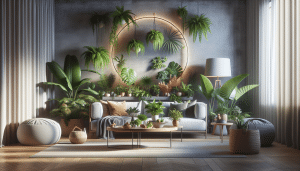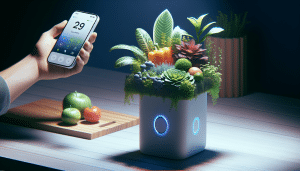Secrets You Might Not Know About Smart Indoor Gardening
Henry King September 23, 2025
Explore the transformative world of smart indoor gardening and how it boosts plant health, improves energy efficiency, and elevates your home’s aesthetic. This guide shares advanced tips, explores benefits, and reviews common technology so you can make the most of your indoor green space.
Understanding Smart Indoor Gardening: Why It Matters
Smart indoor gardening has revolutionized how green spaces flourish inside homes. By combining hydroponic systems, automated lighting, and climate controls, plant enthusiasts enjoy thriving gardens year-round. Smart gardens appeal not only to apartment dwellers but also to anyone wishing for lush greens regardless of space or weather conditions. Automation in watering and lighting helps maintain optimal plant health with minimal intervention. Key systems use sensors that instantly adjust to the plant’s needs, ensuring a longer lifespan and fewer maintenance worries. People are drawn to this technology because it turns once-difficult plant care into a simple, enjoyable routine. As indoor air purity and food production become more important, this innovation offers practical benefits.
Many are surprised at the range of smart garden devices available for home use. From countertop herb gardens to sizable tower systems, there’s something for every space. These devices often feature app integration, allowing you to track plant health and control settings from anywhere. They even make suggestions about when to add nutrients or adjust lighting. Such adaptability is particularly beneficial for those who travel regularly or have unpredictable schedules. For busy individuals, smart indoor gardening eliminates much of the guesswork and hassle, making plant care more accessible than ever.
Beyond automation, smart indoor gardens offer unique opportunities for learning and experimentation. Families often use these systems as educational tools to teach children about plant biology and sustainable living. Smart systems can help urban households grow fresh lettuce, basil, or cherry tomatoes indoors. This not only supports food security but can cut grocery costs and reduce waste. The rise of energy-efficient LED grow lights and water-saving hydroponics highlights the sustainability advantages. In short, integrating smart gardening technology at home creates healthier environments and brings daily joy to many.
Your Guide to Smart Garden Technology Options
Deciding which smart indoor gardening technology suits your needs starts with understanding the range of available solutions. Some setups focus on herb kits with pre-seeded pods and automatic nutrient release. Others offer customizable DIY hydroponic gardens with adjustable nutrient dosing, perfect for plant enthusiasts seeking more involvement. Most systems now include Wi-Fi connectivity and smartphone apps. This not only lets users monitor temperature and humidity but also provides reminders for feeding and watering. Such features ensure even beginners find success with their indoor gardens.
Lighting is another critical element in smart indoor gardening. Full-spectrum LED lights mimic natural sunlight, which is vital for healthy plant growth in dim indoor spaces. Modern systems feature auto-dimming and timing controls to simulate sunrise and sunset cycles, reducing electricity use and supporting plant circadian rhythms. For large installations or vertical farming towers, energy-efficient lighting systems make producing greens at scale manageable at home. As awareness of energy costs increases, these tools help strike a balance between technology use and affordability.
Smart garden sensors are at the heart of automated care. These sensors detect soil moisture, ambient humidity, air temperature, and even sunlight exposure, then send this data back to the central control system. The system can then adjust its behavior automatically to ensure every plant receives tailored care. Some options integrate voice assistants, allowing you to check water levels, request feeding status, or tweak growing conditions through simple commands. This seamless connectivity turns smart indoor gardening into an effortless, engaging experience for all.
Smart Indoor Gardening and Energy Efficiency
Energy-conscious homeowners often ask if smart indoor gardening is efficient. The short answer: yes, especially when the right equipment is chosen. Most modern indoor gardens use LED grow lights, which outperform traditional bulbs in efficiency and longevity. These LEDs can be tailored to emit specific wavelengths, providing the precise spectrum required by plants and reducing wasted energy. This focus on targeted lighting means users see faster, healthier plant growth without spikes in their electricity bills. Systems often include built-in timers and dimmers, further minimizing energy use.
Hydroponic systems are another major contributor to energy and resource savings. Unlike traditional soil gardening, hydroponics requires far less water—sometimes up to 90% less. Automated pumps and nutrient dosing eliminate the guesswork, reducing chances of human error and water waste. Some towers recycle unused water, making the entire growing process both cost-effective and environmentally sustainable. For those aiming to reduce their home’s environmental footprint, these features provide peace of mind and tangible benefits.
The efficiency advantages extend beyond electricity and water. Many smart gardens utilize organic or biodegradable materials for their pods or growing trays. Automated nutrient management reduces the likelihood of overfertilization, which can pollute local water sources. Emphasizing a sustainable approach, these systems promote healthier plants and a healthier indoor environment. By choosing products compliant with Energy Star standards or similar certifications, homeowners can further support environmental goals while enjoying a flourishing green oasis indoors.
Choosing and Placing the Right Plants Indoors
Not all plants thrive equally in every smart garden system. Herbs like basil, mint, and parsley are favored for their fast growth and adaptability to compact living spaces. Leafy greens, such as lettuce and spinach, flourish with minimal care under LED lights. Some systems also accommodate fruiting plants like cherry tomatoes and peppers. The key is selecting varieties suited to limited root space and consistent indoor temperatures. Researching which plants are compatible with your smart gardening technology will maximize your results and enjoyment.
Placement plays an essential role in success. Even with advanced lighting, some plants benefit from proximity to natural sunlight. Positioning your garden near a window—while still providing climate control—can give certain species an extra growth boost. Maintaining small changes in room temperature and humidity also reduces disease and mold risk. For those working with particularly compact or windowless rooms, tower or wall-mounted systems are popular solutions. These maximize vertical space without sacrificing yield.
For larger plants or more ambitious indoor gardens, modular systems offer flexibility. Adding extra growing columns or containers lets enthusiasts expand their plant selection as confidence and skills grow. User communities and online forums provide guidance on troubleshooting and customization, helping hobbyists experiment safely. Combining personal preferences with system guidance ensures a unique and satisfying indoor garden tailored to individual tastes. Over time, this approach can transform plant care into a deeply rewarding hobby or family activity.
Common Challenges and How to Overcome Them
Despite impressive technology, new users sometimes encounter challenges with their smart indoor gardens. Overwatering remains a frequently reported issue, especially when integrating soil-based setups with smart sensors. It is important to regularly calibrate sensors, checking for software updates to ensure accurate readings and notifications. Nutrient imbalances are another issue, usually caused by using generic solutions with plants that require specialized care. Reading guides and consulting reputable resources will help avoid these pitfalls and maintain vigorous growth.
Pest management is different for indoor smart gardens than traditional outdoor plots. While a home environment reduces the risk of infestation, indoor plants can still attract bugs like aphids or fungus gnats. Use natural solutions, such as neem oil or beneficial insects, and ensure proper air circulation with fans or open windows. Routine cleaning of reservoirs, trays, and sensors also keeps systems working smoothly. Preventative care and attention to hygiene are essential for avoiding long-term maintenance headaches.
Finally, some systems have learning curves for first-timers. Syncing devices, updating firmware, or troubleshooting connectivity can take patience. Most manufacturers offer user manuals and customer support for these issues. Online communities and gardening forums are excellent sources for troubleshooting advice. Taking the time to learn your system’s specifics will reward you with more reliable performance and abundant harvests. Persistence and curiosity convert occasional setbacks into valuable lessons for future indoor gardening adventures.
Bringing It All Together: The Benefits of Smart Indoor Gardening for Your Home
Smart indoor gardening delivers more than just healthy greens and pretty flowers. It enhances the overall well-being of those who participate. The act of tending to plants has been shown to reduce stress, support productivity, and improve air quality indoors (Source: https://www.ncbi.nlm.nih.gov/pmc/articles/PMC4419447/). Smart indoor gardens further this benefit by making care easier and more rewarding, empowering people regardless of gardening experience.
These systems contribute to sustainability by enabling year-round local food production without pesticides or excess water usage. Homegrown herbs and vegetables reduce the carbon footprint linked to packaging and transporting food over long distances. As communities become increasingly urbanized, such sustainable solutions play a key role in conscientious lifestyles. Adopting smart indoor gardening technology aligns with broader goals for environmental responsibility, self-sufficiency, and health. Combining these systems with recycling and composting creates a larger positive impact.
Smart gardens bring families together for meaningful activities and create daily connections to nature, even in busy urban settings. The beauty of automated systems lies in their flexibility and scalability—whether starting with a windowsill herb kit or managing a multi-tiered vertical farm, every home can participate. With the right approach and continued curiosity, anyone can discover unexpected joy and satisfaction from nurturing plants indoors.
References
1. Wang, S., Wang, L., & Wang, L. (2015). Benefits of gardening activities for people’s health and well-being: A systematic review. Retrieved from https://www.ncbi.nlm.nih.gov/pmc/articles/PMC4419447/
2. National Renewable Energy Laboratory. (n.d.). LED Lighting. Retrieved from https://www.energy.gov/energysaver/save-electricity-and-fuel/lighting-choices-save-you-money/led-lighting
3. United States Environmental Protection Agency. (n.d.). Water Efficiency for Agriculture. Retrieved from https://www.epa.gov/watersense/watersense-products
4. Green Building Alliance. (n.d.). Indoor Air Quality. Retrieved from https://www.go-gba.org/resources/green-building-methods/indoor-air-quality/
5. University of Florida IFAS Extension. (n.d.). Edible Gardening. Retrieved from https://edis.ifas.ufl.edu/publication/EP486
6. Environmental Protection Agency. (n.d.). Composting At Home. Retrieved from https://www.epa.gov/recycle/composting-home







